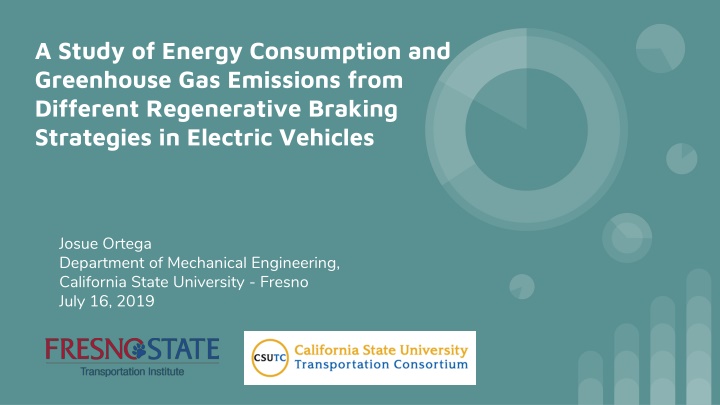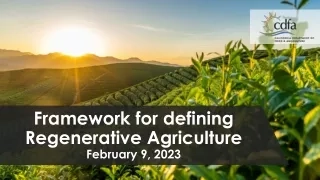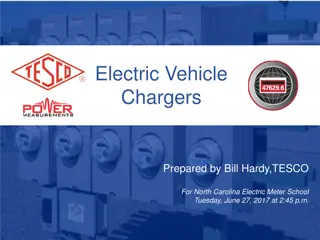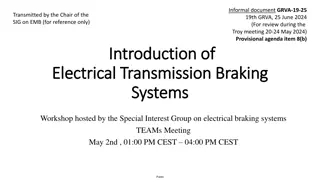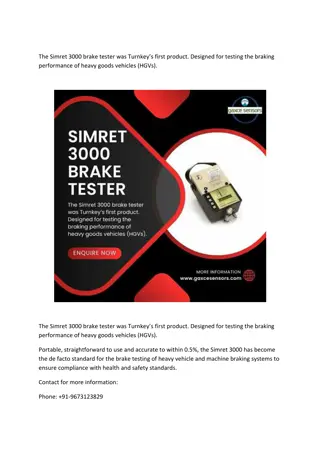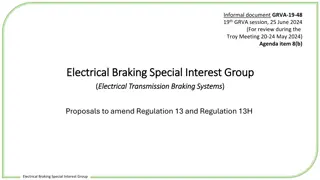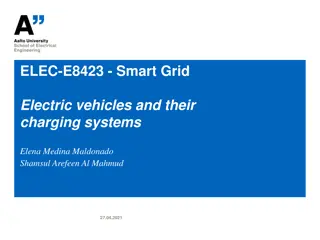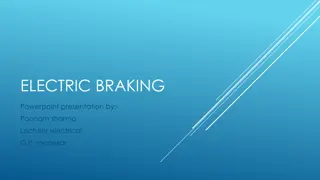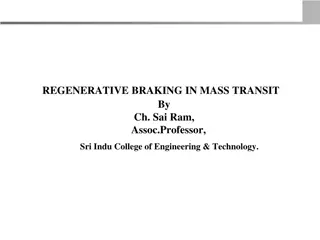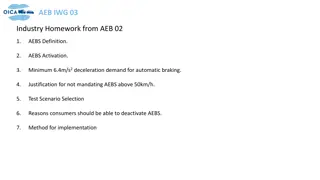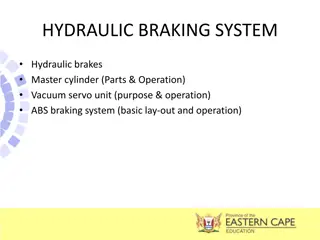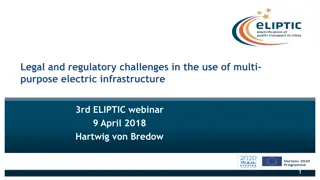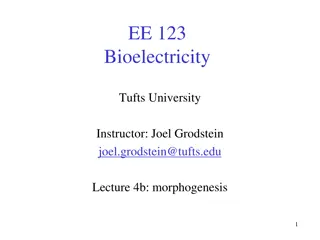Study on Regenerative Braking Effects in Electric Vehicles
Investigating the impact of regenerative braking strategies on energy consumption and greenhouse gas emissions in electric vehicles, this study by Josue Ortega from California State University - Fresno delves into improving regenerative braking system performance through data analysis and calculations based on the Nissan Leaf. By analyzing factors like travel demand and road conditions, the research aims to enhance energy efficiency in EVs and reduce carbon footprints.
Download Presentation

Please find below an Image/Link to download the presentation.
The content on the website is provided AS IS for your information and personal use only. It may not be sold, licensed, or shared on other websites without obtaining consent from the author.If you encounter any issues during the download, it is possible that the publisher has removed the file from their server.
You are allowed to download the files provided on this website for personal or commercial use, subject to the condition that they are used lawfully. All files are the property of their respective owners.
The content on the website is provided AS IS for your information and personal use only. It may not be sold, licensed, or shared on other websites without obtaining consent from the author.
E N D
Presentation Transcript
A Study of Energy Consumption and Greenhouse Gas Emissions from Different Regenerative Braking Strategies in Electric Vehicles Josue Ortega Department of Mechanical Engineering, California State University - Fresno July 16, 2019
Content Outline Background Methodology Results Brief Summary Acknowledgements 2 Josue Ortega
Background B.S. - Biomedical Engineering, UC Davis; M.S. - Mechanical Engineering, CSU Fresno Electric vehicles (EVs) will account for 24% of the U.S. light vehicle fleet by 2030. [1] Central Question: How can the regenerative braking system (RBS) perform better to improve overall energy efficiency in an EV? Energy recuperated by RBS depends on factors like temperature, travel demand, vehicle age, road conditions, etc. [2] The objective of my research is to study how improving the RBS affects energy consumption and GHG emissions in EVs. This is done by carrying out data analysis using parameters based on the Nissan Leaf. [1] Becker TA, Sidhu I, Tenderich B. Electric vehicles in the United States: a new model with forecasts to 2030. Center for Entrepreneurship & Technology (CET) Technical Brief 2009(2009.1). [2] J. L.Oliver, "Regeneration and Brake Management System," U.S. Patent 7647997 3 Josue Ortega
Travel Demand Ref.: U.S. Federal Highway Administration, 2013 Data 4 Josue Ortega
EV Battery Model Multi-physics Model: NMC Ref.: 1. Xie et al. J Power Sources, 284(2014), 172-179 Ref.: 2. Xie et al. Electrochimica Acta, 127(2014), 266-275 5 Josue Ortega
Methodology: Improving RBS Performance Using travel demand, we can calculate the average energy consumed per EV, and then calculate the equivalent greenhouse gas (GHG) emissions in each state From the open publication Spichartz et. al., they developed a model for a typical EV in dry road conditions that finds the recovered energy by the RBS for: An EV with a single-drive system The same EV with a four-wheel drive system The difference in energy recovered can be calculated as: This ratio is used to calculate how using a four-wheel drive design can improve RBS performance to boost energy savings and further prevent GHG emissions Spichartz, Philipp, Tim Bokker, and Constantinos Sourkounis. "Comparison of electric vehicles with single drive and four wheel drive system concerning regenerative braking." Ecological Vehicles and Renewable Energies (EVER), 2017 Twelfth International Conference on. IEEE, 2017. 6 Josue Ortega
Methodology: Calculating Battery Cycles Used After accounting for battery degradation (Based on the EV Battery Model), the true number of battery cycles used to meet the travel demand for each U.S. state can be found by the following equation: 7 Josue Ortega
Methodology: Calculating Energy Savings and Prevented GHG Emissions Energy Used = Number of Cycles * Energy Consumption * Initial Capacity Energy Saved = Energy Used * % Erec* % Improvement in Erec CO2,EqPrevented = Energy Saved * Annual CO2,EqTotal Output Emission Rate The CO2,Eqtotal output emission rates for each U.S. state are provided by the 2016 eGRID Summary Tables Report (Given as lbs CO2,Eq/ MWh) 8 Josue Ortega
Results: Combined Energy Savings for Varying Years of Battery Service Life 9 Josue Ortega
Results: Energy Saved in California Using Different % Improvements in Erec More energy is saved the higher improvement in Erecis. This is more evident when accounting for battery degradation. the % 10 Josue Ortega
Results: Energy Saved in California with Variable Battery Degradation If the battery degradation rate increased, more energy can be saved the longer the same battery is used. 11 Josue Ortega
Results: Total Prevented GHG Emissions for Varying Years of Battery Service Life 12 Josue Ortega
Results: GHG Prevented in California Using Different % Improvements in Erec More CO2emissions are prevented the higher the % improvement in Erecis. This is more evident when accounting degradation. for battery 13 Josue Ortega
Results: GHG Emissions Prevented in California with Variable Battery Degradation If the battery degradation rate increased, more CO2 emissions can be prevented the longer the same battery is used. 14 Josue Ortega
Results: Original Battery Capacity vs. 10% Improvement 15 Josue Ortega
Brief Summary The objective of this research was to study how improving the RBS affects energy consumption and GHG emissions in EVs. Energy saved and GHG emissions prevented improves more over several years of battery service life just by using a four-wheel drive vehicle design More significant in states with larger populations, more local miles driven, and higher annual travel demand Total energy saved and GHG emissions prevented increases if the battery degradation rate of the battery being used in the EV is faster If original battery capacity is increased, energy saved and GHG emissions prevented slightly decreases 16 Josue Ortega
Acknowledgements A Very Special Thank You to: Dr. Yuanyuan Xie (Research Advisor) Fresno State Lyles College of Engineering Fresno State Transportation Institute Claude C. Laval Jr. Award for Innovative Technology and Research, Fresno State 17 Josue Ortega
Thank You! Questions? 18 Josue Ortega
